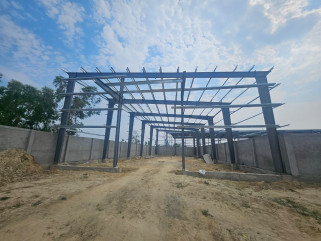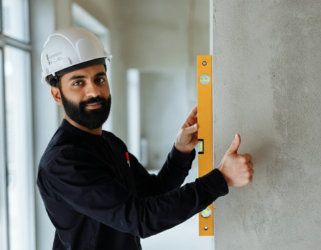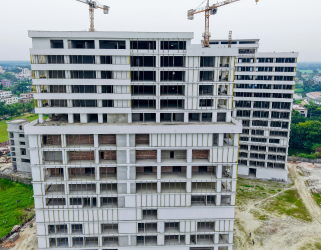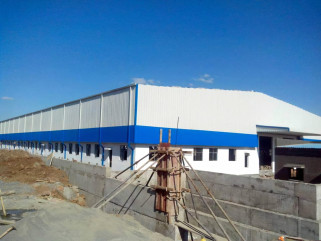What is Composite Construction and How It Enhances PEB Shed Efficiency?

Picture an industrial shed that not only looks robust but also performs exceptionally well under pressure — a structure optimized for space, strength, and longevity. This is where composite construction comes into play, revolutionizing the way Pre-Engineered Buildings (PEB) are designed and utilized. If you're in the construction industry, understanding the power of combining materials like steel and concrete is crucial to staying ahead of the curve. But what exactly is composite construction, and how does it enhance PEB shed efficiency? Let's explore.
The Basics of Composite Construction
At its core, composite construction is a method where two or more materials with distinct properties are integrated to create a structure that leverages the strengths of both. Typically, in the case of industrial buildings, this involves combining steel and concrete to form steel-concrete composite structures. While steel is known for its tensile strength, concrete provides superior compressive strength. Together, they create a synergy that results in a stronger, more efficient structure than either material could achieve independently.
Imagine the perfect partnership — steel acts like the skeletal framework of a building, offering flexibility and durability, while concrete fills the gaps, distributing weight evenly and adding a layer of rigidity. This harmonious blend ensures cost-effectiveness, durability, and adaptability, making it an ideal choice for industrial and PEB applications.
Understanding Pre-Engineered Buildings and Their Role in Modern Construction
Pre-engineered buildings, or PEBs, are prefabricated structures meticulously designed to meet specific requirements. They are widely used in industrial settings like warehouses, factories, and sheds due to their cost and time efficiency. PEB construction technology capitalizes on streamlined fabrication and assembly processes, ensuring swift completion of projects without compromising on quality.
Now, when we bring composite construction into the mix, the benefits multiply. A composite structure in PEB design enhances the versatility and functionality of these buildings, pushing the boundaries of what they can achieve.
How Composite Construction Elevates PEB Shed Efficiency
1. Optimizing Structural Efficiency
One of the most significant challenges in industrial shed construction is ensuring structural efficiency while maintaining cost-effectiveness. Composite construction addresses this by reducing material wastage and capitalizing on the unique strengths of steel and concrete. The result? A composite PEB shed that can bear heavy loads, stand firm against environmental stressors, and remain lightweight enough for easy assembly.
For instance, a steel-concrete composite slab can replace traditional concrete ones in a roof system, reducing the overall dead weight and making the structure more efficient without compromising on its load-bearing capacity. This optimized weight-to-strength ratio is a hallmark of structural efficiency in PEB buildings.
2. Enhanced Space Utilization
Space is a premium resource, especially in industrial sheds where every square foot matters. Composite construction enables slender columns and beams, maximizing usable floor area while ensuring structural integrity. Imagine an industrial shed composite design where column-free spans dominate, allowing for uninterrupted production lines or storage systems. This is a crucial advantage for industries aiming to optimize their operations.
Additionally, slimmer profiles for structural components not only save space but also reduce construction costs by using less material while maintaining or improving strength.
3. Improved Durability and Safety
Safety is non-negotiable in industrial environments. Composite construction shines in this department by offering superior durability. The marriage of steel and concrete creates a resilient structure capable of withstanding fire, corrosion, and seismic activities. This means that composite PEB sheds are not only efficient but also safer for long-term industrial use.
For example, a composite beam resists buckling under pressure better than conventional materials, ensuring the structure retains its integrity even under extreme conditions. This is particularly important in regions prone to earthquakes or other natural disasters.
4. Sustainability and Cost Efficiency
While upfront costs for composite construction might be slightly higher than conventional methods, the long-term savings are evident. Reduced maintenance, longer durability, and more efficient resource utilization result in lower lifecycle costs. Furthermore, composite PEB sheds are aligned with sustainable construction practices, as they minimize material waste and energy consumption during production and assembly.
Companies looking to integrate environmentally friendly practices into their operations will find composite PEB designs a compelling solution, as they balance the demands of modern industry with a minimal environmental footprint.
Benefits of Composite Construction for Industrial Applications
To recap, here are some of the key benefits of composite construction in PEB applications that make it a game-changer for industrial setups:
- Strength Meets Flexibility: The fusion of steel and concrete ensures that structures are not only robust but also versatile enough to adapt to various industrial requirements.
- Optimized Load Distribution: With the unique properties of steel-concrete structures, load stresses are effectively distributed, enhancing overall structural integrity.
- Faster Construction Timelines: Pre-engineered components combined with composite materials significantly reduce construction times, helping industries meet tight deadlines.
- Cost and Material Efficiency: Less wastage, fewer materials, and longevity make composite structures a cost-efficient solution.
- Adaptability to Design Needs: Composite structures in PEB construction technology offer the flexibility to customize industrial sheds according to specific operational needs.
The Future of Industrial Shed Composite Design
Composite PEB sheds represent the future of efficient, durable, and sustainable industrial construction. By improving weight distribution, maximizing usable space, and ensuring long-term reliability, composite construction is setting new benchmarks for pre-engineered building technology. Whether it's for manufacturing, storage, or logistics, these cutting-edge sheds redefine what’s possible in industrial spaces.
Metrosh — Your Trusted Partner in Composite Construction
When it comes to innovative construction solutions, Metrosh stands tall as a trusted leader in composite construction. With a commitment to 100% customization, Metrosh designs and delivers composite PEB sheds that optimize space utilization while providing exceptional strength and safety. Whether your goal is to enhance operational efficiency or create a durable structure tailored to your needs, Metrosh’s expertise ensures results that exceed expectations. Choose Metrosh, and experience the next level of efficiency and reliability in industrial construction.
Our Services
Pre-Engineered Buildings | Civil Construction | Hybrid Constructions | Best Construction Company
FAQs
1. What is composite construction in PEB sheds?
It’s the use of steel and concrete together in structural elements. This combo boosts strength and efficiency in industrial sheds. Steel provides flexibility, while concrete adds durability.
2. How does it improve PEB shed efficiency?
Composite construction increases load capacity and reduces waste. It enables faster builds and larger, more usable interior spaces. You get a stronger shed with better space utilization.
3. What are the key materials?
Key materials are structural steel, reinforced concrete, and shear connectors. Together, they create unified and robust building systems for PEB sheds.
4. Is it more cost-effective than conventional methods?
Often, yes. Slightly higher initial costs are offset by lower maintenance and greater durability, delivering better long-term value than traditional PEB methods.
5. Can it reduce shed weight?
Yes, composite methods allow lighter structural sections without sacrificing strength. This is ideal for wide-span industrial sheds.
Related Articles

Why Pre-Engineered Buildings Are the Ultimate Cost-Saving Solution?
24 Sep 2025
Strong, Durable, and Long-Lasting: The Structural Superiority of PEBs
23 Sep 2025
Quality Control in Civil Construction: Metrosh Infra’s Standards and Practices
22 Sep 2025
Cost-Efficiency in Hybrid Construction: Balancing Budget and Quality
22 Sep 2025
Building the Future: Metrosh Infra’s Approach to Turnkey Civil Construction
20 Sep 2025


